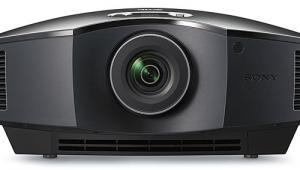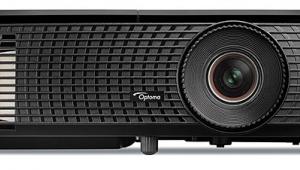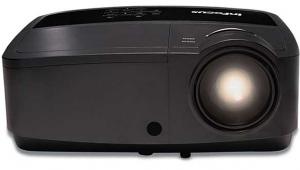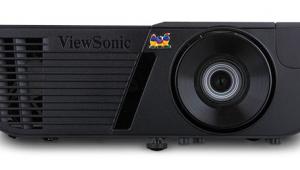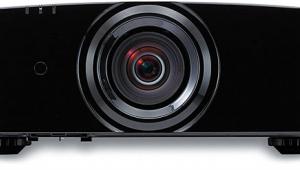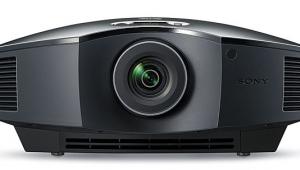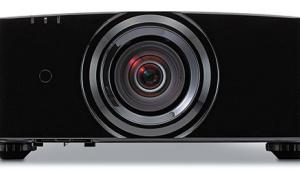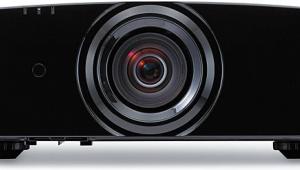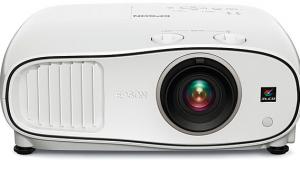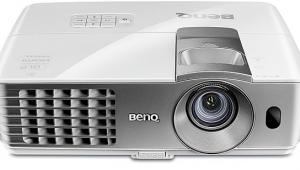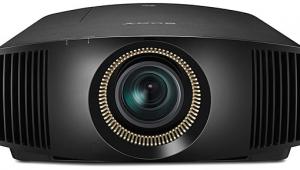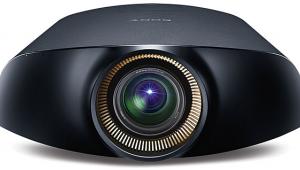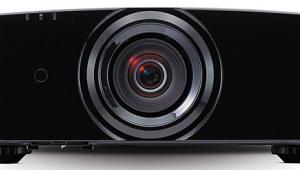Mitsubishi HC7800D 3D DLP Projector Page 2
2D Performance
The projector’s video processing produced mixed results. It failed the HD and SD 2:2 deinterlacing tests—though these are common failures among the displays we’ve tested. It also failed the clipping test by not going below video black (brightness level 17).
The projector does not clip above white. But when set up for a peak brightness of approximately 16 foot-lamberts on the 101-inch-wide, 1.1-gain, 2.35:1 Elite screen I used for most of this review, white test patterns had a clearly visible magenta tint from just below peak white to above. I could eliminate this by reducing the Contrast to –15, from my preferred setting of zero. But at –15, the peak brightness dropped to just over 10 ft-L. This wouldn’t be an issue on a smaller or higher-gain screen, but the Mitsubishi needed to be pushed a bit further than perhaps it’s comfortable with to reach a brightness level I find satisfying.
 Test patterns are one thing, but I had to determine if that magenta problem affected normal program material. The Art of Flight is a white-level, sunlit nightmare about mentally deranged snowboarders seeking the thrill of victory, oblivious to the agony of defeat. If magenta was going to be a problem on any source, it would be this one.
Test patterns are one thing, but I had to determine if that magenta problem affected normal program material. The Art of Flight is a white-level, sunlit nightmare about mentally deranged snowboarders seeking the thrill of victory, oblivious to the agony of defeat. If magenta was going to be a problem on any source, it would be this one.
When I looked really hard, I thought I occasionally saw a hint of the dreaded magenta. But it was elusive at best and easy to ignore. It was also completely innocuous on more typical program material. Perhaps it was hard to see even on The Art of Flight because the Mitsubishi looked so stunning on this disc that it was difficult to concentrate on anything besides the compelling picture. There was no visible clipping or crushing of the brilliant whites (the most common sign of a too-high contrast level). The color was breathtaking (yes, there’s actually life beyond white on this film), and the resolution left nothing to be desired.
There aren’t any truly dark scenes in The Art of Flight, but there are plenty in Mission: Impossible—Ghost Protocol, particularly in the early Moscow scenes. The Mitsubishi handled them extremely well, apart from the occasional DLP rainbow. Yes, I did see rainbows on this projector, though not often enough to be a significant distraction. (Occasional rainbow artifacts are inherent on single-chip DLP projectors that use a color wheel, though viewer sensitivity to them varies.) The Mitsubishi also handled the other qualities of this brilliant transfer beautifully, doing color and detail as flawlessly as you’re likely to experience on pricier projectors—though the latter might earn their stripes on screens far larger than mine.
On the HBO miniseries Game of Thrones (Season 1, Chapter 8, Blu-ray), the projector’s color was hard to fault, even within this production’s relatively pale color palette. Fleshtones were totally believable, the blood was red (there’s a lot of flesh and blood in this show), and green foliage—though in short supply on this material—never looked unnatural. The picture was uniformly sharp and detailed on the Mitsubishi—as good on my 8.5-foot-wide screen, in fact, as with most feature films. The dark scenes in this production, and there are plenty of them, were impressive as well, with one exception: A wide expanse of near black in a dungeon scene looked a little too grayish. Fleeting rainbows also showed up here as well; bright lights (flickering torches in this case) against near-black backgrounds are the type of material most likely to produce these artifacts. But I found them minor and easy to ignore even here—and I’m very sensitive to them.
Finally, another documentary, The Magic of Flight (flight is big here this month), knocked me out on this projector. I can’t recommend this Blu-ray highly enough and can’t imagine it looking much less spectacular than it did on the Mitsubishi. Apart from a few slightly soft shots obviously captured in standard definition, this disc, featuring the training and performances of the Navy’s Blue Angels, is a riveting visual (and audible), jaw-dropping treat. Originally an IMAX production, it was so compelling when cropped onto the full width of my 2.35:1 screen that I never sensed anything missing.
3D Performance
As with all 3D displays we’ve tested, the Mitsubishi must be pushed to its limits for the viewer to experience even a shadow of its 2D brightness. I turned the contrast up as much as I dared, risking the Wrath of the Magenta Titans. BrilliantColor, which I studiously avoided in 2D, produced a little additional pop. And a +2 setting on the sharpness control (maximum +5) helped with resolution, which is always shortchanged by a dimmer picture. (Normally, I set sharpness to zero in 2D, but a setting of +1 helped there as well as on sources with less-than-pristine resolution.)
Even with all of these compromises, including the somewhat low gamma in the 3D Gamma mode, the projector calibrated respectably in 3D up to around 80 percent brightness. But above that level, a loss of red turned the measurement in a pronounced green-blue direction, increasing the top-end color temperature to over 8000K. This was not, however, visibly obvious on any of the 3D material I viewed.
The Mitsubishi’s 3D performance was outstanding. The dimmer image was tolerable, and after a few minutes’ viewing I hardly noticed it. The images were crisp, the color good—if a little less pristine than in 2D, as noted above—the depth outstanding, and the blacks deep and rich, with good shadow detail.
I also checked out 3D discs that have shown 3D ghosting on other displays, but I didn’t see any at all on the Mitsubishi. I suspect I’d see one or two with dozens of hours of viewing, but for all practical purposes, this projector was ghost free. 3D was also, interestingly, free of rainbows, for which credit must go, I suspect, to the dimmer image.

Some of the 2D picture controls are locked out in 3D. As discussed earlier, the Screen Size control selects either CinemaScope (2.35:1), which masks the top and bottom of the 1.78:1 image, or full 16x9. When you switch to 3D, however, this control is locked out and fixed in the last position it was set to for 2D. If you want to change it, you have to turn the 3D mode off, make the change, then turn 3D on again.
Also, if you set up one AV Memory mode for 2D and another for 3D, as I did, you’ll find another oddity. If you turn the 3D control off in the AV Memory mode you’ve set up for 2D, which of course you will, the Mitsubishi will also make this change automatically to your 3D AV Memory settings. So when you next go to the 3D AV Memory mode, you’ll find that the 3D setting is off and you’ll have to manually turn it back on again. And vice versa. Weird.
At first it appeared that the Frame Rate Conversion (F.R.C.) control and its associated F.R.C. Level control were locked out in 3D—and locked into their default settings of True Film and Level 4. You can change this, but to do so you first have to turn 3D off, change the Frame Rate Conversion and F.R.C. Level controls to your desired settings, and then turn 3D back on. Interestingly, however, in 3D, as in 2D, the projector’s frame interpolation didn’t put me off as much as I might have expected, probably because the Mitsubishi’s motion interpolation works so well.
Mitsubishi’s optional 3D IR glasses are some of the most expensive on the market. They’re also heavy, with thick eyepieces and tight ear supports. While less comfortable than some of the new models we’ve seen, such as those from Panasonic and Samsung, they’re tolerable, even when worn over regular glasses. Their replaceable batteries are not rechargeable. The 3D IR emitter for the glasses comes with relatively short connecting cable. Fortunately, in my room, with the emitter near the projector, I was able to bounce its trigger signal off the screen and back to the main viewing area, a round trip of about 26 feet.
Conclusions
Yes, the Mitsubishi has a few issues and omissions. There’s that magenta shift at the top of the brightness range when it’s pushed for a satisfying 2D brightness on a relatively large, low-gain screen. But it was largely invisible with program material. The projector doesn’t go below black, but I was still able to set the black level (and when it’s set correctly, you aren’t supposed to see below black anyway). Then there’s the physical positioning limits and the lack of motorized lens adjustments. But with a ceiling mount, neither of these should be a concern. And finally, there’s the non-defeatable motion interpolation in 3D, which may or may not trouble you.
But when I fed it a quality source, the Mitsubishi continually surprised me in ways I didn’t expect, and its picture truly floored me more than once. There are other projectors that cost a bit more than the Mitsubishi’s street price that offer additional features and somewhat better black levels. But the HC7800D is definitely in the hunt, and I enjoyed every minute I spent with it. For me, that’s Top Pick territory, and highly recommended.
- Log in or register to post comments
